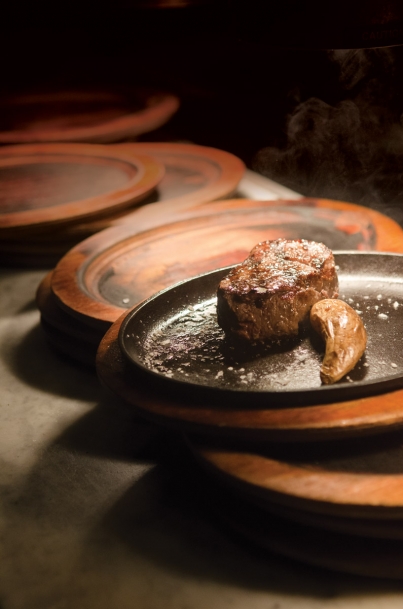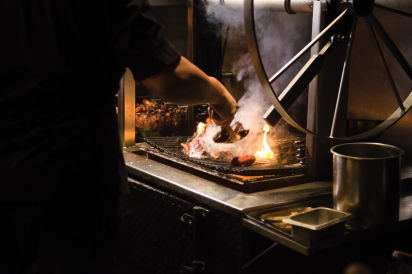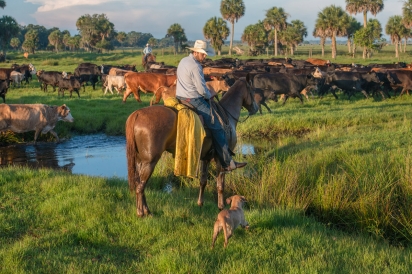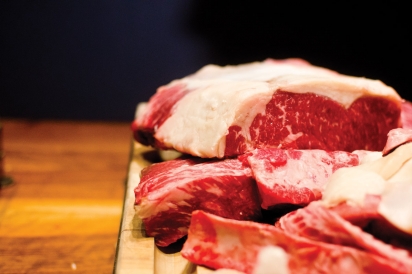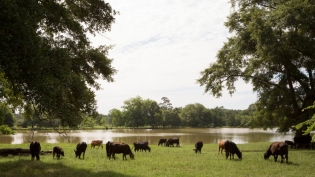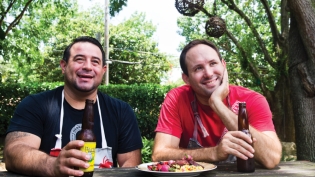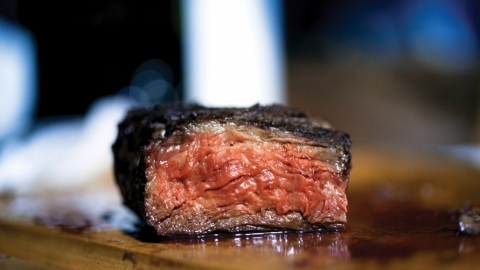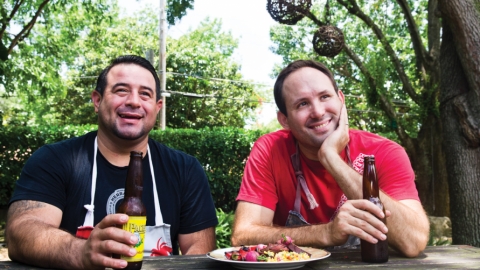The Skinny on Beef
Not that long ago, if you wanted burgers for a cookout, you picked up a couple of pounds of ground beef from the grocery store. Today, your choices are endless. Was that cow humanely raised? Grass-fed? Antibiotic-free? Any hormones? Organic? Which farm did it come from?
To understand the business of beef from the eyes of a small Southern farmer, consider the story of White Oak Pastures, a family farm in Bluffton, Georgia, a couple of hours northwest of Tallahassee. Soon after the Civil War, the farm was founded by Captain James Edward Harris. Every Saturday, he and the sharecroppers on the land butchered a cow, some hogs and a few chickens to feed everyone. In the early 1900s, when his son was in charge, they did their butchering six days a week. They hauled the meat on a mule-drawn wagon up a dirt road and delivered it to the town’s general stores, hotel and boarding house.
It was after World War II that the traditional system of raising and harvesting livestock was upended. Slaughtering and processing moved away from small farms to central locations. The Harris farm – along with many others – raised calves for the commoditized industrial beef production system. Then, in 1995, Will Harris III decided to return the farm to the farming practices of the early days, operating as a living ecosystem, treating animals humanely and producing meats and other foods not as commodities, but as artisan creations.
Like farmer and author Joel Salatin of Polyface Farms and some other family farmers, the Harrises have turned to the past for inspiration and direction in raising food for today’s consumers who insist on humanely and sustainably raised beef. “We pasture-raise and hand-butcher 10 species of animals,” says Jenni Harris, Will’s middle daughter, and the fifth generation of the Harris family to tend cattle at White Oak Pastures. Everything gets used, she says. “We compost inedible viscera and bones into organic fertilizer for the soil. We use the hides and fat from the grass-fed beef animals to make leather goods and tallow soap. White Oak Pastures is a closed-loop farm.”
The Beef Biz
Fueled by health and environmental concerns – and a steady stream of food documentaries from 2008’s Food, Inc. to Cowspiracy in 2014 – the public’s appetite for beef is changing. Eating too much red meat has been linked to cardiac disease and certain types of cancer. There are concerns about disease outbreaks, like E. coli bacteria contamination found in beef and salmonella linked to feed containing animal products. The environmental impact of rearing cattle is considerable, requiring energy and water. Cow burping and flatulence – cow farts – are responsible for producing as much as 150 billion gallons of methane gas each day as greenhouse gas emissions. Consumers also care about animal welfare, eating animals that have been humanely raised and treated. And just as they want to know the farmer who grows their tomatoes, they want to know who’s raising their beef.
How that steak ends up in your cart is likely a more convoluted path than your heirloom tomato takes. It starts with beef cows, which may well have been raised in Florida. With nearly a million head of cattle, Florida ranked 10th in beef cows and 18th in total cattle at the beginning of 2016, according to the USDA’s National Agricultural Statistics Service. Once those calves are weaned, nearly all are shipped to feedlots in the Midwest and Colorado, where they are fattened up on grain, harvested – slaughtered -– and processed. The beef then gets shipped off to restaurants, grocery stores and customers through distributors and providers.
Beef products come from grain-fed cattle; cattle that were partly grass-fed, then were “corn-finished” at the feedlots; and exclusively grass-fed cattle that feed on grasses and forage.
Feedlot cows grow much faster than grass-fed cattle, making their beef cheaper, and their fatty, meaty flavor is what many are used to. Feedlots mean more beef for more people, and that’s not a bad thing, says lawyer Steve Ehrlich of Select Foods in South Florida, a family-run business that provides meat and poultry to a wide variety of businesses and also has a USDA-approved processing center. “I think we’re feeding the world,” he says. The process is now “humane, efficient, using every part of the animal, not causing it to suffer, affordable. You’re seeing a more discerning customer,” he says, one who is concerned about animal welfare. “Mistreatment is terrible and illegal,” he says, adding that there’s nothing wrong with the nature of the feedlot. Grass-fed beef is more expensive because it takes longer for cattle to get to their slaughter weight. Like feedlot cows, they can be managed humanely – or not.
Homegrown Florida Beef
Some of Florida’s cattle ranchers want to keep it local instead of sending their calves on a truck for a 22-hour ride to the feedlots out west. The Florida Cattle Ranchers group, founded in January 2016 by 13 ranchers, wants to build a sustainable program, according to its mission: “Our beef comes from quality yearlings that live less-stressed, wholesome and natural lives in one state … We leave our yearlings to graze, feed and water without overworking and processing.” Raising high-quality beef using humane practices will also improve the environment by reducing the carbon footprint, and support open spaces and wildlife habitats, the group says. It will take some time to build the program – Florida still has limited processing facilities. But by early 2017, the group hopes to provide Florida beef under its own logo, says spokesperson Jolie Davis. “We want Florida Cattle Ranchers products to have their own QR code, so customers can scan and see where the cows came from.”
And for some restaurateurs, using local Florida beef is an essential way to support the community and know what you’re getting firsthand. Alex Rodriguez of the family-owned Palomilla Grill in Miami says he buys his skirt steak, palomilla and picanha from Seminole Pride, one of Florida’s top producers, because “transparency is a big deal,” he says. “I want to be able to see what I’m getting.”
Further Afield
Grass-fed beef is imported to the U.S. from Australia, New Zealand and South America. Pablo Liberato of Gaucho Ranch in Miami works with local and domestic U.S. certified organic meat suppliers, but it is grass-fed beef cuts from the pampas of Uruguay that are the stars of his Miami shop. “It is succulent, more gamey, with a stronger flavor profile,” compared to the mild, sweet flavor of corn-fed beef. “The flavor is so good there’s no need to cover with sauces – top it with salt, pepper, maybe a little grass-fed butter, olive oil or coconut oil.”
Pasture-raised meats are leaner, lower in calories and have a higher omega-3 content than typical grain-fed steaks, and makes you feel less stuffed, he says. Liberato, who talks to students about grass-fed beef at the Miami Culinary Institute every year, says that because the beef is leaner, “you really need to know how to prepare it. If you pass the cooking point, it will dry out faster.” He recommends starting with premium cuts – steaks, ribeye, strip loin, flap meat, tenderloin. He is always ready to talk about the benefits of grass-fed beef with consumers, restaurateurs and their staff to educate them. “We will always be a niche market,” he says. “There’s not enough land in the U.S. for grass-fed.”
Types of Cattle
Angus beef cattle The most popular breed in the U.S. The Certified Angus Beef program was established to make sure cattle labeled as Angus could trace at least half of their genetic material to true Angus sources.
Heritage breeds Traditional livestock breeds selected and bred over time to develop traits that made them well-adapted to the local environment. Florida Cracker is one of the oldest breeds of cattle in the United States, descending from Spanish cattle brought to the New World in the early 1500s. Another is Parthenais, a vintage French breed featured by Arrowhead Beef. In May, Heritage Breeds Week raises awareness about endangered heritage breeds of livestock and poultry in America.
Wagyu Japanese cattle that’s genetically predisposed to intense marbling, which provides enhanced flavor, tenderness and juiciness. Also known as Kobe-style beef, although only beef raised in the Kobe prefecture of Japan can be called “Kobe,” a brand name. American Wagyu is a cross of Wagyu and American Black Angus.
Know Your Terms
USDA Prime Prime grade beef has lots of marbling and comes from young, well-fed beef cattle.
USDA Choice Choice beef has less marbling than prime, but is still high quality.
USDA Organic Animals are raised in living conditions accommodating their natural behaviors (like the ability to graze on pasture), fed 100% organic feed and forage, and not administered antibiotics or hormones.
Grain-fed Cattle were raised on grass, but are fed grain at some point. They came from a large or a small farm.
Grass-fed Fed nothing but grass from weaning to harvest.
Dry aging Fresh beef hung to dry for several weeks under controlled temperature, air flow and humidity to enhance flavor and tenderness. Dry aging causes the meat to lose some of its weight in liquid, thus concentrating its flavor.
Wet aging Meat is vacuum-packed and refrigerated to improve tenderness and flavor.


